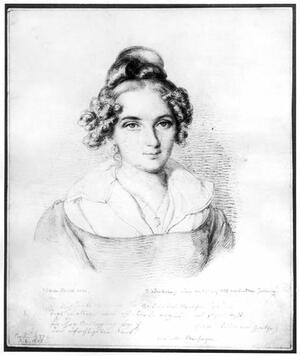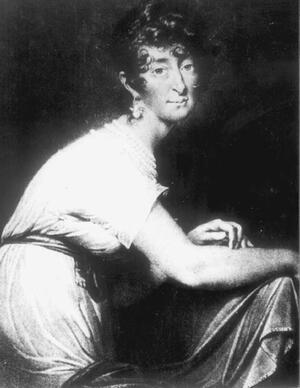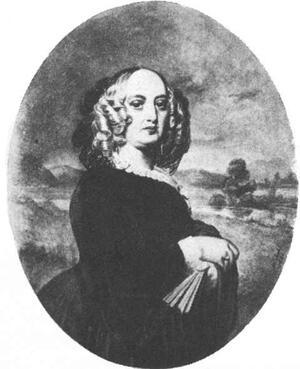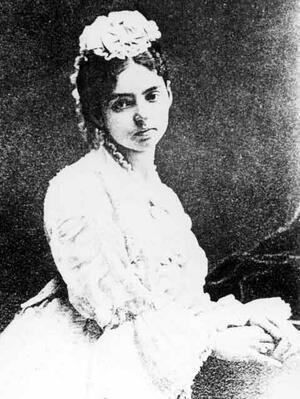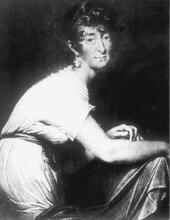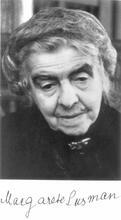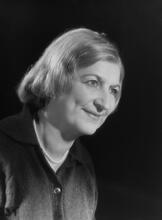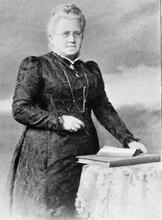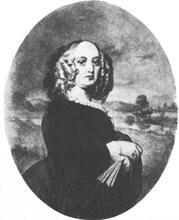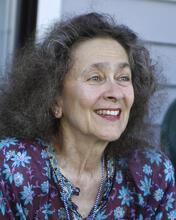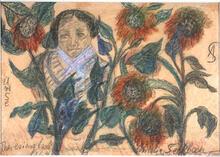Berlin Salons: Late Eighteenth to Early Twentieth Century
The Berlin salons that developed in the late eighteenth century owed both their existence and the form of their development to Jewish women. These early salons were the result of a unique interrelation between the German enlightenment and young, educated Jewish women from well-to-do families searching for a new role in life outside the patriarchal structures of their families. These salons have variously been criticized as a symptom of failing Jewish tradition or welcomed as a phenomenon of emancipation and acculturation. Regardless, their importance as highlights of the salon culture and for the process of women’s emancipation in Germany cannot be denied.
Introduction
The Berlin salons that developed in the late eighteenth century owed both their existence and the form of their development to Jewish women. These early salons were the result of a unique interrelation between the German enlightenment and Jewish Enlightenment; European movement during the 1770sHaskalah on the one hand and, on the other, young, educated Jewish women from well-to-do families, who were searching for a new role in life outside the patriarchal structures of their families. These salons have variously been criticized as a symptom of failing Jewish tradition or welcomed as a phenomenon of emancipation and acculturation. Whatever one’s attitude, their importance as highlights of the salon culture and for the process of women’s emancipation in Germany cannot be denied. The formal structure of the Berlin salons was built on principles of French salon tradition (both the aristocratic salon and, even more, its modified version: the modest bourgeois salon or tea-table). In the later nineteenth-century salon culture, salons held by Jewish women remained an important part of the Berlin salon life (until the end of the salons circa 1914).
While in Paris by the mid-eighteenth-century salons had become a traditional social institution and even bourgeois ladies had advanced to be salonnières, Berlin society, in comparison, was very old-fashioned. The social classes remained strictly separated (with a very exclusive, but largely poor aristocracy at the top); Jews were discriminated against by Prussian law and socially stigmatized. It took a long time for a Bildungsbürgertum (an educated middle class) to develop, especially as there was no university in Berlin until 1810. Middle-class women were not supposed to engage in cultural activities, but only in their religious and household duties. The rich but small Jewish upper class in Berlin had a protected status in exchange for its financial and economic services to the crown. Their lifestyle after the end of the Seven Years’ War (1763) became aristocratic. Daughters from these families, born around 1760, became the first Jewish salon women. Most important were the Itzig daughters—Sara Levy (1761–1854) in Berlin and Fanny von Arnstein in Vienna. The first Berlin salons by Jewish women, however, were of the more modest Bildungsbürgertum model, which afterwards became typical for the Berlin salons.
The eminent personality of Moses Mendelssohn (1729–1786) changed the life of some Jews in Berlin by encouraging them to take part in secular (German) education and literature. The ultimate aim was to demonstrate their fitness for civil rights. The famous friendship between Mendelssohn, Friedrich Nicolai (1733–1811), and Gotthold Ephraim Lessing (1729–1781) and Lessing’s ring parable (from Nathan the Wise) propagated and popularized religious tolerance and acceptance. It was not a level playing field, since Christians set up the rules and seldom treated Judaism as worthy of respect. Jews gave up more of their religious traditions than did Christians, but enlightened Christians also moved away from religious authority.
Beginning in the 1780s, we find Christians and Jews side by side at the tea-tables of gifted and enthusiastic (upper) middle-class Jewish women who, born in the 1760s, had grown up in the Mendelssohn era. Many had enjoyed an excellent education (like the Itzig daughters), others developed a passion for reading and learning on their own, assisted by their husbands and friends (like Henriette Herz and Rahel Levin Varnhagen). The social, political, and intellectual basis was provided by enlightenment philosophy, augmented by poetical and philosophical emancipation of individual feeling. These social, not yet political ideals may be generalized as liberty, equality, and fraternity. Just as philosophy, poetry, and music united educated individuals from different religions, the salons of Jewish women formed a neutral, somewhat extraterritorial meeting ground for all those who wanted to bridge the gaps of rank in traditional Christian feudal society.
From Late Absolutism to the Decree of Emancipation: 1780–1812/1815
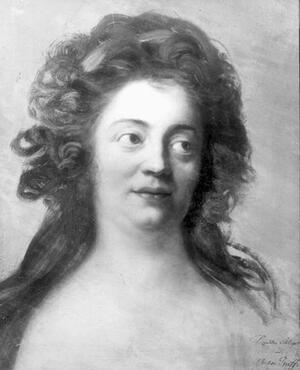
The daughter of German-Jewish philosopher Moses Mendelsohn, author Dorothea Schlegel, née Brendel Mendelsohn, abandoned her father's religion, the husband he had chosen, and even the name he had given her at birth, to marry the controversial Christian literary theorist Frederick Schlegel.
Institution: Gidal-Bildarchiv im Salomon Ludwig Steinheim-Bildarchiv für deutsch-jüdische Geshichte e.g., Duisberg
The majority of Berlin salons at this time were without pretensions of “high life” and were bent on simplicity, genuine feelings, amusement, and mutual education without pedantry. Henriette Herz, née de Lemos, who with her husband took part in the early reading societies, can be regarded as the first salonnière in Berlin. She was a close friend of Mendelssohn’s eldest daughter Dorothea Schlegel. Herz’s husband, the eminent physician and philosopher Marcus Herz (1747–1803), encouraged her to read and study languages and science. The friends they entertained at home soon split into the elder champions of the enlightenment, who discussed scientific and philosophical questions, and a group of young men, among them poets and authors, who preferred to drink tea and read and discuss poetry and prose with Marcus Herz’s beautiful wife. The scholar and writer Karl Philipp Moritz (1756–1793), a habitué of the Herz salon, installed the cult of young Goethe in this circle. Later on, the emphasis on German classical literature and neohumanism brought forward the ideals of the so-called harmonious personality, the right and duty to strive for individual perfection of mind, soul and body. Free conversations, in which people could profit from each other’s thoughts, tastes, ideas and samples of favorite literature, music, and art, could best be put into practice in salon society. Though later Henriette Herz’s fame was overshadowed by that of her younger rival Rahel Levin, it was Herz who created the style of the typical educated bourgeois salon in Berlin: a simple tea-table with a charming hostess, enthusiasm for reading and discussing literature, sparkling conversation, and an atmosphere of friendship.
While Henriette Herz’s salon was the typical literary salon, Rahel Levin Varnhagen created a very individualistic salon concept. In fact, it was more a philosophical and psychological meeting point than a literary salon. She displayed a clear but restless and passionate mind and a generous heart and had suffered the pain of two broken engagements with noblemen. Though very interested and competent in literature, Rahel was even more fascinated by living people, their thoughts, feelings, opinions, and perceptions. Understanding people and things was her passion; her position as a “mother-confessor” to various interesting personalities, including the composer and war-hero Prince Louis Ferdinand of Prussia (1772–1806), constituted one of the incentives for her social life. Apart from traditional sources of thinking and contemporary philosophical influence, the English philosopher Anthony Ashley Cooper, Earl of Shaftesbury (1671–1713), who was highly esteemed by Mendelssohn, seems to have formed her mind and way of thinking: that misconceptions, clichés, and prejudices must be continually counteracted by ever new and never-ending reflection about the world (and oneself). Herein lies the root of Rahel’s frequently quoted “originality” and of her important influence on the spirit of Berlin salons.
Enthusiasm for Goethe was an important and constant ingredient of these salons. One of the Berlin salonnières in the 1790s was the Goethe-enthusiast Sara Meyer (1763–1828), who married Ferdinand Dietrich von Grotthuß. For some time, charming Pessel Cohen (c. 1776–after 1804, who adopted the name Philippine around 1800), a descendant of the wealthy Bernhard family, was very influential. The literary North Star Club met in her salon. Among its members were Karl August Varnhagen von Ense (1785–1858), Adelbert von Chamisso (1781–1838), Wilhelm Neumann (1781–1834), and Heinrich von Kleist (1777–1811). Her salon ended and her traces disappear after the 1804 bankruptcy of her husband, which left her destitute. Several intellectual women who, strictly speaking, did not have salons themselves in Berlin, were habituées and later had salons elsewhere: they included Dorothea Mendelssohn Veit, who met Friedrich Schlegel at Herz’s salon and later married him, and Rebecca Friedländer (Regine Frohberg; 1783–1850). Both settled in Vienna.
By 1800 there were also some Jewish salons in Berlin that were modelled more closely on the French aristocratic salons. Two extremely influential salonnières, who did not convert and whose salons existed until the middle of the nineteenth century, were Amalie Beer and Sara Levy. Amalie Beer (1767–1854), wife to Jacob Herz Beer (1769–1825), a banker and sugar manufacturer and supporter of the Jewish Enlightenment; European movement during the 1770sHaskalah, held a brilliant open house. Together with her husband she played a leading role in the Berlin “reform temple” movement. Sara Levy, née Itzig (1761–1854), was a banker’s widow, childless, strictly conservative, with a brilliant mind and a classical education. Though her salon was too conventional for the taste of many romantic poets, Levy’s composure was never shaken and commanded respect from almost everyone. Levy and Beer also frequently gave excellent dinners (with invitations), while any acquaintance might drop in for tea at the jours fixes. Because some of the salonnières kept the laws of The Jewish dietary laws delineating the permissible types of food and methods of their preparation.kashrut it was often easier to invite Christian guests to a Jewish dinner table than the other way round. However, the problem remained restricted to orthodox women like Levy, since many middle and upper-class Berlin Jews of that time did not observe the ritual laws. In any case, the refreshments served in Christian and Jewish salons of the prevailing “tea-table type” in Berlin had to be very simple (“thin tea and thin slices of bread-and-butter”), as a salonnière could not know how many guests would attend her next jour fixe.
Revolutions at the Tea-Table
The social, cultural, and religious innovations at the salon tea-tables reached a climax by 1800. An important social characteristic of the early Jewish Berlin salon circles was their tendency to exogamous and hypergamous marriages, their contribution to social mobility by providing marriage connections of beautiful, rich and/or clever young ladies with young men outside their own social circle, often with men of the aristocracy. The fact that several women not only fell in love but married out of their traditional circle (sometimes even breaking up earlier marriages) was an important factor in changing traditions.
For Jewish salon women, aristocratic marriage, though raising their social status, necessitated conversion, since civil law marriage did not exist. Though many of the young women were daughters of intellectually distinguished fathers, they felt restricted by the subordinate role traditionally assigned to women in the patriarchal structures of orthodox Jewish life. Nevertheless, most of the converted salon women of that time did not forget family and old friends. They presented a model for Jewish integration into the changing German society, although a model that most Jews rejected. Meanwhile, by 1800, there were also salons in Berlin headed by non-Jewish salonnières: some in the aristocratic tradition (the Duchess Dorothea of Courland, Princess Luise Radziwill), some from the Bildungsbürgertum (e.g., Sophie Sander). Gradually, they became ready to open their doors to Jewish friends and acquaintances (though these were few at first); this process slowly created an integrated general salon society in Berlin.
The salon circles welcomed the American fight for freedom and the early moderate stages of the French Revolution, which proclaimed the rights of man. They realized the necessity of reforms even in Prussia’s “enlightened despotism.” One of Henriette Herz’s friends, Christian Wilhelm (von) Dohm (1751–1820), had written his essay Über die bürgerliche Verbesserung der Juden in 1781, and it is likely that the salons contributed to the process of Jewish emancipation and legal equality. Several of those who later became champions of social and political modernization in Prussia (among them many reformers of the years 1807–1812) were or had been habitués of the Berlin salons. In 1812 the decree of emancipation was intended to give equal civil rights to the Jews in Prussia but failed to do so because it was not fairly applied and increasingly encumbered by restrictions.
Soon many serious setbacks occurred. The ideas of enlightenment gave way to a new era of traditionalism in the later stages of Romanticism, which often included ressentiments against Jews. Antisemitic pamphlets and articles, as well as social discrimination, in the first years of the nineteenth century could poison some minds, but they could not destroy the trend towards emancipation and salon society.
Integration: Biedermeier and Liberal Ideas in Salon Society: 1815–1880
In the spectrum of Berlin salon society after 1815, the salons of Jewish women or baptized Jewish women constantly played an important part, though they ceased to be a new and revolutionary phenomenon. After the crown had withdrawn important rights and promises of the reform era, the salons generally remained places where freedom of conscience and speech was respected. The mutual visits of Jewish and Christian salon women in their respective salons increased. The non-Jewish salonnières in Berlin, a considerable number of aristocratic ladies, wives of bourgeois civil servants, publishers etc., were usually on excellent terms with their Jewish colleagues. It was a hallmark of salon society, perhaps more in theory than practice, that people were respected for their character and merits and not for rank, origin or religion.
However, only Rahel Varnhagen’s “second salon” of 1818–1833 was of historical significance. Rahel Levin-Robert, since 1814 married to the diplomat Karl August Varnhagen von Ense, returned to Berlin in 1818 after a four-year absence. Though her “second salon” attracted even more guests than her first, she was not really satisfied with her gatherings. She complained that she gave more than she received, which was probably true. Varnhagen’s frustration was partly due to the reactionary politics after 1815. The antisemitic disturbances in Southern Germany in 1819 really shocked her. However, Varnhagen’s salon had become legendary by the 1820s. The cult of Rahel Varnhagen (even if it was an idealized version of her), inaugurated in 1834 by Rahel. Ein Buch des Andenkens für ihre Freunde and followed by other letter-publications edited by her widower, became an integral part of later nineteenth-century Berlin salon culture and salon lore.
Among the Jewish women who continued the salon tradition was Henriette Solmar (1794–1890), perhaps a convert. Her salon existed for more than half a century, culminating in the 1830s, 1840s, and 1850s. As a confirmed liberal, Solmar received and comforted the political writer Heinrich Laube (1806–1884) after his release from unjust imprisonment in 1835. During the revolution of 1848 she was an admirer of Alphonse de Lamartine (1790–1869). In spite of her outspoken opinions, guests from different political quarters kept visiting her for news and political gossip. Among her international guests were Thomas Carlyle (1795–1881) and George Eliot (1819–1880).
Sara Levy and Amalie Beer were very active elderly ladies now. The latter, meanwhile, had attained the status of a “Berlin original” by her dry comments. Beer’s famous sons, among them the composer Giacomo Meyerbeer (1791–1864), were to be found at her salon and the concerts arranged by her rivalled those in the house of Lea Mendelssohn Bartholdy (1777–1842) and her gifted children Fanny (1805–1847) and Felix (1809–1847). Sara Levy presided at the tea-table in her house on the (later so-called) museum-island in Berlin for more than half a century, a close neighbour to salonnières and authors like Bettine von Arnim (1785–1859), Henriette Paalzow (1788–1847), and Hedwig von Olfers (1799–1891), who became her good friends. Combining cultural conservativism with ideas of political progress, a grande dame with charm and inner poise, Levy was a phenomenon. A devoted admirer of Johann Sebastian Bach (she had been a pupil of Friedemann Bach), Levy supported her great-nephew Felix Mendelssohn Bartholdy when he planned to perform Bach’s Matthäus-Passion at the Singakademie in 1829. Levy kept encouraging young authors and painters (especially women, Jewish and non-Jewish alike) until her death in 1854. The feminist Fanny Lewald claimed that frail old women like Levy and Henriette Herz (whom she met at Levy’s tea-table in the early 1840s) had, by their spirited personalities, broken the barriers of caste and prejudice and helped to impregnate social life in Berlin with a refined culture of the mind.
The revolution of 1848–1849 failed, but though the final Prussian constitution of 1850 was unsatisfactory, equal rights for Jews were incorporated. They were subsequently curtailed in the conservative 1850s. Shared political disappointments united liberal Christians and Jews in Berlin, and integration continued. Henriette Solmar’s salon was still very important, her guests forming connections with other liberal salons of younger Christian women like Ludmilla Assing (1821–1880) and Lina Duncker (1825–1885). One of the most prominent salonnières of her time was Fanny Lewald from Königsberg, who had converted from Judaism. She came to Berlin in the 1840s, married the author Adolf Stahr (1805–1876) and had a salon from the mid–1850s. Fanny Lewald represents a new type of salonnière. She was a successful novelist, had strong (even at first democratic) political opinions and wrote feminist books. Her salon was only one part of her activities. She became a model for many Jewish and non-Jewish salon women and early feminists in Berlin and the whole of Germany.
In the age of Bismarck, many distinguished politicians were Jews or of Jewish origin and many of them were habitués in the salons, whether Jewish or Christian. Very soon the Kulturkampf against the Catholic Church brought as a side-effect civil marriage, which facilitated matches between persons of different creeds. In salon circles, there was no doubt about the growing integration and acceptance of Jewish Germans.
The End of Salon Culture: 1880-1914
There were many new salons when Berlin became capital of the German empire in 1871, but while the population grew, salons were in decline. An interesting salon gathered round Babette Meyer (1835–1916), a banker’s daughter, clever, spirited, a good amateur painter. For some time, she was an intimate in the house of chancellor Bismarck. In 1886 she made a (disastrous) marriage to the eccentric painter Stanislaus Graf Kalckreuth (1821–1894). Around the turn of the century Walther Rathenau (1867–1922), who was interested in Berlin salon history, liked to visit this circle, where he met old ladies whose memories reached back to the 1830s.
One of the last really influential salons in Berlin was that of Felicie Bernstein, née Rosenthal (1850–1908), from St. Petersburg. She was the wife of the eminent Roman Law scholar Carl Bernstein (1842–1894), who in 1886 became an “extraordinary” professor at Berlin university. Scholars, writers, musicians ,and, most important, painters and art historians felt at home in Bernstein’s salon, dominated by the lady of the house with her charming character, sparkling wit and social talents. One of the most faithful habitués was the painter Max Liebermann (1847–1935). As the Bernsteins were (or were among) the first owners of impressionistic paintings in Berlin, lively discussions about old and modern art ensued in their salon. Such discussions later led to the founding of the influential Berlin Secession. After the early death of her husband Felicie Bernstein became interested in social problems and the feminist movement but retained her enthusiasm for art and left a legacy to the Secession. Another patron of modern art was Amalie Beer’s granddaughter Cornelie Meyerbeer-Richter (1842–1922), widow of the painter Gustav Richter (1823–1884). In her salon (in 1900) Richter arranged lectures by the art nouveau architect and designer Henry van de Velde (1863–1957). Though not really a salonnière, the hospitable wife of an industrial magnate, Johanna Arnhold, née Arnthal (1860–1929), should be mentioned in this context, because she played an important role in the Berlin Society of Female Artists and Friends of Art. This is symptomatic: Step by step, salon society itself faded into the background, while outside (social and cultural) activities of the salonnières increased.
A special case among the salons of industrialists’ and bankers’ wives in the Kaiserreich was the Fürstenberg salon. In 1889 the renowned (and witty) banker Carl Fürstenberg (1850–1933), managing director of the Berliner Handelsgesellschaft, married Aniela Treitel, née Natanson (1856–1915), from Warsaw, whom an unhappy first marriage had turned into an independent-minded woman and something of a feminist. She proved to be a superb hostess. At a time when many salons tended to “specialize” (in art, music, politics, etc.), her guests were an interesting mix of all spheres of literature, theatre, music and the arts, business and finance, politics and diplomacy. Later in life she even combined her salonnière qualities with those of a businesswoman: she managed company receptions and made speeches for her busy husband who was very grateful for this assistance.
Achievements and Limits of the Salons
In the late nineteenth century salon culture was still enjoying a kind of Indian summer. The fin de siècle and art nouveau as well as some currents of modern life and literature even brought some late highlights. At that time many salonnières had mixed family connections and intermarriages in salon society proliferated. Just like the first salons a century earlier, these late salons attempted to provide free and equal society in which people were respected for their individual qualities and not for their origins. Yet these rules (as always in the history of the salon) were valid only within the salons and the salon network. When anti-Jewish propaganda arose around 1880, most of the prominent Christian champions for fairness were, besides the socialists, members of the salon society. The Berlin salons on the one hand gave the new (pseudo-scientific racist) antisemitism no chance at all to conquer them, but on the other hand, these salons as such—given their loose structure—were unable to prevent or defeat it successfully, especially because at that time the influence of the salon society, in comparison with mass society and its public institutions, was shrinking and negligible. World War I, the end of the monarchy, inflation and the subsequent impoverishment of those middle and upper middle classes who had formed the backbone of salon society were only external signs that the era of the salons had ceased. Heroic attempts to reinstall salons, e.g., by Edith Andreae, née Rathenau (1883–1952), in the 1920s, created last sparkling highlights of intellectual “open houses,” but could not save salon culture as a whole in Berlin. However, throughout the entire nineteenth century Berlin salons had succeeded in promoting cultural liberty, equality and fraternity for all educated persons, including women and Jews. It was not the fault of Moses Mendelssohn’s concepts or of the optimism of salon society that the cultural and humanitarian principles of the enlightenment were swept away in the twentieth century.
This bibliography excludes literature dealing with individual salonnières who have their own articles in the Encyclopedia. There are a few exceptions in the case of sources which are relevant for the whole of the salon society in Berlin. As the content of an article is usually indicated by the title, only books have been commented upon.
Selection of Important Primary Sources and Collections of Sources
Bunsen, Marie von. Die Frau und die Geselligkeit. Leipzig: [c. 1915].
Bunsen, Marie von. Zeitgenossen, die ich erlebte. 1900–1930. Leipzig: 1932.
Heilborn, Ernst, ed. Die gute Stube. Berliner Gesellschaft im 19. Jahrhundert. Vienna, Munich, Leipzig: 1922.
[Herz, Henriette.] Henriette Herz in Erinnerungen, Briefen und Zeugnissen, ed. by Rainer Schmitz, Frankfurt/Main: 1984. Cf. also: Landsberg, Hans, ed. Henriette Herz. Ihr Leben und ihre Zeit. Weimar: 1913. Not fully reliable.
Lepsius, Sabine. “Über das Aussterben der ‘Salons’.” März. Eine Wochenschrift, seventh year, vol. 3 (1913): 222–234.
Lepsius, Sabine. Ein Berliner Künstlerleben um die Jahrhundertwende. Erinnerungen, ed. by Monica Behrendt. Munich: 1972.
Lewald, Fanny. Meine Lebensgeschichte, ed. by Ulrike Helmer, vol. 3: Befreiung und Wanderleben. Frankfurt/Main: 1989. Earlier editions of this source: Berlin: 1861 (original edition), and in Fanny Lewald’s collected works, Berlin: 1871.
[Olfers, Hedwig von.] Hedwig von Olfers geb. von Staegemann, ed. by Hedwig Abeken. 2 vols., Berlin: 1908–1914.
Strube, Rolf, ed. Sie saßen und tranken am Teetisch. Anfänge und Blütezeit der Berliner Salons. Munich, Zurich: 1991.
Tornius, Valerian, ed. Der ästhetische Tee. Die Berliner Gesellschaft von 1800 bis 1900. Berlin: 1921.
Varnhagen, Rahel. Gesammelte Werke, ed. by Konrad Feilchenfeldt, Uwe Schweikert and Rahel E. Steiner. 10 vols., Munich: 1983. (Rahel-Bibliothek.)
Secondary Literature
Altendorfer, Norbert. “Geselligkeit als Utopie. Rahel und Schleiermacher.” In Berlin zwischen 1789 und 1848. Facette einer Epoche. Ausstellung der Akademie der Künste vom 30. August bis 1. November 1981, ed. by Barbara Volkmann, 37–42. Berlin: 1981 (Akademie-Katalog, 132).
Arndt, Andreas. “Geselligkeit und Gesellschaft. Die Geburt der Dialektik aus dem Geist der Konversation in Schleiermachers ‘Versuch einer Theorie des geselligen Betragens’.” In Salons der Romantik. Beiträge eines Wiepersdorfer Kolloquiums zu Theorie und Geschichte des Salons, ed. by Hartwig Schulz, 45–61. Berlin, New York: 1997.
Arendt, Hannah. “Berliner Salons.” Deutscher Almanach für das Jahr 1932 (1932): 173–184.
Augustine, Dolores L. “Die jüdische Wirtschaftselite im wilhelminischen Berlin: Ein jüdisches Patriziat?” In Jüdische Geschichte in Berlin. Essays und Studien, ed. by Reinhard Rürup, 101–116. Berlin: 1995.
Bähtz, Dieter. “Zur Funktion des literarischen Salons um 1800.” Wissenschaftliche Zeitschrift der Martin-Luther-Universität Halle-Wittenberg, Gesellschaftswissenschaftliche Reihe, 19 (1970): 43–50.
Bilski, Emily D., Emily Braun, and Leon Botstein. Jewish Women and Their Salons: The Power of Conversation. Jewish Museum under the auspices of the Jewish Theological Seminar of America, 2005.
Boeschenstein-Schäfer, Renate. “Das literarische Leben 1800–1850.” In Berlin und die Provinz Brandenburg im 19. und 20. Jahrhundert, ed. by Hans Herzfeld, assisted by Gerd Heinrich, 657–699. Berlin: 1968. (Geschichte von Brandenburg und Berlin, vol. 3, Veröffentlichungen der Historischen Kommission zu Berlin beim Friedrich-Meinecke-Institut der Freien Universität Berlin, vol. 25).
Bovenschen, Silvia. Die imaginierte Weiblichkeit: Exemplarische Untersuchungen zu kulturgeschichtlichen und literarischen Präsentationsformen des Weiblichen. Frankfurt/Main: 1979.
Brammer, Annegret H. Judenpolitik und Judengesetzgebung in Preußen 1812 bis 1847 mit einem Ausblick auf das Gleichberechtigungsgesetz des Norddeutschen Bundes von 1869. Berlin: 1987.
Bruer, Albert A. “Die Berliner Salons.” In Geschichte der Juden in Preußen (1750–1820), 211–225. Frankfurt/Main, New York: 1991.
Brunschwig, Henri. Enlightenment and Romanticism in Eighteenth Century Prussia. Chicago: 1974.
Dick, Jutta and Marina Sassenberg. Jüdische Frauen im 19. und 20. Jahrhundert. Lexikon zu Leben und Werk. Reinbek near Hamburg: 1993.
Dollinger, Petra and Heinz. “Der Geschmack des deutschen Bürgertums im Zeitalter des Biedermeier (1815–1830).” In Heinrich August Marschner. Bericht über das Zittauer Marschner-Symposium, ed. by Allmuth Behrendt and Matthias Theodor Vogt. Ein Symposium des Instituts für kulturelle Infrastruktur Sachsen, 121–216. Leipzig: 1998. (Kulturelle Infrastruktur, vol. 5.).
Dollinger, Petra. “Die internationale Vernetzung der deutschen Salons (1750–1914).” In Europa—ein Salon? Beiträge zur Internationalität des literarischen Salons, ed. by Roberto Simanowski, Horst Turk and Thomas Schmidt, 40–65. Göttingen: 1999. (Veröffentlichung aus dem Sonderforschungsbereich 529 “Internationalität nationaler Kulturen”, Serie B: Europäische Literaturen und internationale Prozesse, ed. by Horst Turk and Fritz Paul, vol. 6.).
Dollinger, Petra. “Fürst Pückler und die literarischen Salons seiner Zeit.” Vortrag Schloß Branitz, 28. Oktober 1998. In Pückler – Pyramiden – Panorama. Neue Beiträge zur Pücklerforschung, ed. by Stiftung Fürst Pückler Museum Park und Schloß Branitz, 196–226. Cottbus: 1999. (Edition Branitz, vol. 4.).
Dollinger, Petra. “Die jüdische Salontradition in Berlin. Vom späten 18. Jahrhundert bis zum Ersten Weltkrieg.” In Mitteldeutsches Jahrbuch für Kultur und Geschichte, ed. for the Stiftung Mitteldeutscher Kulturrat by Christof Römer. Vol. 8, 75–102. Cologne, Weimar, Vienna: 2001.
Drewitz, Ingeborg. Berliner Salons. Gesellschaft und Literatur zwischen Aufklärung und Industriezeitalter. Third edition, Berlin: 1984 [1965].
Drewitz, Ingeborg. “Die literarischen Salons. Ihr Beitrag zur Berlinischen Urbanität.” In Emuna 9 (1974): 26–31.
Feilchenfeldt, Konrad: “Die Anfänge des Kults um Rahel Varnhagen und seine Kritiker.” In Juden im Vormärz und in der Revolution von 1848, ed. by Walter Grab und Julius H. Schoeps, 214–232. Stuttgart, Bonn: 1983.
Feilchenfeldt, Konrad: “Die Berliner Salons und Briefkultur.” Der Deutschunterricht 36 (1984): 77–99.
Feilchenfeldt, Konrad. “Rahel Varnhagens ‘Geselligkeit’ aus der Sicht Varnhagens. Mit einem Seitenblick auf Schleiermacher.” In Salons der Romantik. Beiträge eines Wiepersdorfer Kolloquiums zu Theorie und Geschichte des Salons, ed. by Hartwig Schulz, 147–169. Berlin, New York: 1997.
Geiger, Ludwig. Geschichte der Juden in Berlin. Als Festschrift zur zweiten Säkularfeier. Im Auftrage des Vorstandes der Berliner Gemeinde bearbeitet. Berlin: 1871.
Gleichen-Rußwurm, Alexander von. Geselligkeit. Sitten und Gebräuche der europäischen Welt 1789–1900. Stuttgart: 1909.
Goodman, Kay. “The Impact of Rahel Varnhagen on Women in the Nineteenth Century.” In Gestaltet und gestaltend: Frauen in der deutschen Literatur, ed. by Marianne Burkhard, 125–153. Amsterdam 1980 (Amsterdamer Beiträge zur neueren Germanistik, vol. 10).
Grab, Walter. “Der preußische Weg der Judenemanzipation”. In Juden in Preußen. Ein Kapitel deutscher Geschichte, ed. by Bildarchiv Preußischer Kulturbesitz, 24–29. Dortmund: 51987.
Hahn, Barbara. Unter falschem Namen. Von der schwierigen Autorschaft der Frauen. Frankfurt a. M.: 1991.
Hahn, Barbara. The Jewess Pallas Athena: This Too a Theory of Modernity. Translated by James McFarland. Princeton University Press, 2005.
Heilborn, Ernst. Die gute Stube. Berliner Gesellschaft im 19. Jahrhundert. Vienna, Munich, Leipzig: 1922.
Hertz, Deborah. “Salonnières and Literary Women in Late Eighteenth Century Berlin.” New German Critique 14 (1978): 97–108.
Hertz, Deborah. “Intermarriage in the Berlin Salons.” Central European History 16 (1983): 303–346. German translation: “Mischehen in den Berliner Salons.” Bulletin des Leo Baeck Instituts 79 (1988): 37–74.
Hertz, Deborah. “Seductive Conversion in Berlin, 1770–1809.” In Jewish Apostasy in the Modern World, ed. and with an introduction by Todd M. Endelman, 48–82. New York, London: 1987.
Hertz, Deborah. Jewish High Society in Old Regime Berlin. New Haven, London: 1988. (Revised edition of: The Literary Salon in Berlin, 1780–1806: The Social History of an Intellectual Institution. Phil. Diss. University of Minnesota 1979, Ann Arbor, Michigan: 1979.) German translation under the title: Die jüdischen Salons im alten Berlin. Frankfurt/Main: 1991.
Hertz, Deborah. "Work, Love and Jewishness in the Life of Fanny Lewald." In Profiles in Diversity. Jews in a Changing Europe, 1750–1817, ed. by Frances Malino and David Sorkin. chapter 9, 202–220. Detroit: 1998. This edition was first published under the title: From East and West: Jews in a Changing Europe, 1750–1817. Oxford, U.K., Cambridge, Mass.: 1991.
Honigmann, Peter. “Alexander von Humboldt und die Juden.” In Zur Freiheit bestimmt. Alexander von Humboldt – eine hebräische Lebensbeschreibung von Chaim Selig Slonimski (1810–1904), ed. by Kurt-Jürgen Maaß, transl. from the Hebrew by Orna Carmel, 53–54. Bonn: 1997.
Kabus, Petra. Der romantische Salon. In Blühende Landschaften. Romantik in Brandenburg. Ein Lesebuch, ed. by Petra Kabus, Andreas Keller and Knut Kiesant, 63–69. Berlin: 2002.
Kayserling, M.[eyer]. Die Jüdischen Frauen in der Geschichte, Literatur und Kunst. Leipzig: 1879 [Rpr. Hildesheim, Zürich, New York: 1991].
Lowenstein, Steven M. The Berlin Jewish Community. Enlightenment, Family, and Crisis, 1770–1830, chapter 9, 104–110. New York, Oxford: 1994.
Lowenstein, Steven M. “Jewish Upper Crust and the Berlin Jewish Enlightenment: The Family of Daniel Itzig.” In Profiles in Diversity. Jews in a Changing Europe, 1750–1817, ed. by Frances Malino and David Sorkin, chapter 8, 182–201. Detroit: 1998. First published under the title: From East and West: Jews in a Changing Europe, 1750–1817. Oxford, U.K., Cambridge, Mass.: 1991.
Lund, Hannah Lotte. "„Über Die Bürgerliche Verbesserung“– Der Berliner Jüdische Salon Um 1800 Im Schnittpunkt Der Diskurse." In Der Berliner "jüdische Salon" Um 1800: Emanzipation in Der Debatte, 53-140. Berlin; Boston: De Gruyter, 2012.
Meixner, Horst. “Berliner Salons als Ort deutsch-jüdischer Symbiose.” In Gegenseitige Einflüsse deutscher und jüdischer Kultur von der Epoche der Aufklärung bis zur Weimarer Republik. Internationales Symposium, April 1982, ed. by Walter Grab, 97–109. Tel Aviv: 1982 (Jahrbuch des Instituts für deutsche Geschichte).
Meyer, Bertha. Salon Sketches. Biographical Studies of Berlin Salons of the Emancipation. New York: 1938.
Meyer, Michael A. The Origins of the Modern Jew. Jewish Identity and and European Culture in Germany, 1749–1824. Detroit: 1967.
Miller, Norbert. “Literarisches Leben in Berlin im Anfang des 19. Jahrhundert. Aspekte einer preußischen Salon-Kultur.” In Kleist-Jahrbuch 1981/82: Internationales Kleist-Kolloquium 1981, ed. by Hans Joachim Kreutzer, 12–32. Berlin: 1983.
Naimark-Goldberg, Natalie. "Reading and Modernization: The Experience of Jewish Women in Berlin around 1800." Nashim: A Journal of Jewish Women's Studies & Gender Issues, no. 15 (2008): 58-87.
Quennell, Peter, ed. Affairs of the Mind: The Salon in Europe and America from the Eighteenth to the Twentieth Century. Washington, D.C.: 1980.
Reibnitz, Kurt [von]. Die große Dame. Von Rahel bis Kathinka. Dresden: 1931.
Remy [-Lazarus], Nahida Ruth. Das jüdische Weib. Mit einer Vorrede von Moritz Lazarus. Third edition, Berlin: 1896 [11891].
Schulz, Hartwig, ed. Salons der Romantik. Beiträge eines Wiepersdorfer Kolloquiums zu Theorie und Geschichte des Salons. Berlin, New York: 1997.
Seibert, Peter. Der literarische Salon. Literatur und Geselligkeit zwischen Aufklärung und Vormärz. Stuttgart, Weimar: 1993.
Siebel, Ernst. Der großbürgerliche Salon 1850–1918. Geselligkeit und Wohnkultur. Berlin: 1999.
Simanowski, Roberto, Horst Turk and Thomas Schmidt, eds. Europa—ein Salon? Beiträge zur Internationalität des literarischen Salons. Göttingen: 1999. (= Veröffentlichung aus dem Sonderforschungsbereich 529 “Internationalität nationaler Kulturen,” Serie B: Europäische Literaturen und internationale Prozesse, ed. by Horst Turk and Fritz Paul, vol. 6.)
Weissberg, Liliane. "Der Jüdische Salon in Berlin (und Wien) Um 1800." In Handbuch Der Deutsch-jüdischen Literatur, edited by Horch Hans Otto, 60-69. Berlin/Boston: De Gruyter, 2016.
Wilhelmy, Petra. Der Berliner Salon im 19. Jahrhundert (1780–1914). Berlin, New York: 1989 (Veröffentlichungen der Historischen Kommission zu Berlin, vol. 73).
Wilhelmy-Dollinger, Petra. “Emanzipation durch Geselligkeit. Die Salons jüdischer Frauen in Berlin zwischen 1780 und 1830.” In Bild und Selbstbild der Juden Berlins zwischen Aufklärung und Romantik, ed. by Marianne Awerbuch and Stefi Jersch-Wenzel, 121–138. Berlin: 1992 (Einzelveröffentlichungen der Historischen Kommission zu Berlin, vol. 75).
Wilhelmy-Dollinger, Petra. “Die Berliner Salons und der Verein der Künstlerinnen und Kunstfreundinnen zu Berlin.” In Profession ohne Tradition. 125 Jahre Verein der Berliner Künstlerinnen, ed. by the Berlinische Galerie [...] in cooperation with the Verein der Berliner Künstlerinnen, 339-352. Berlin: 1992.

